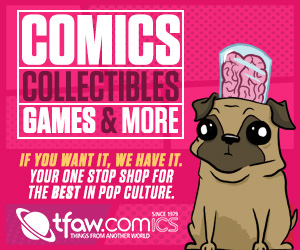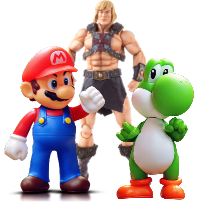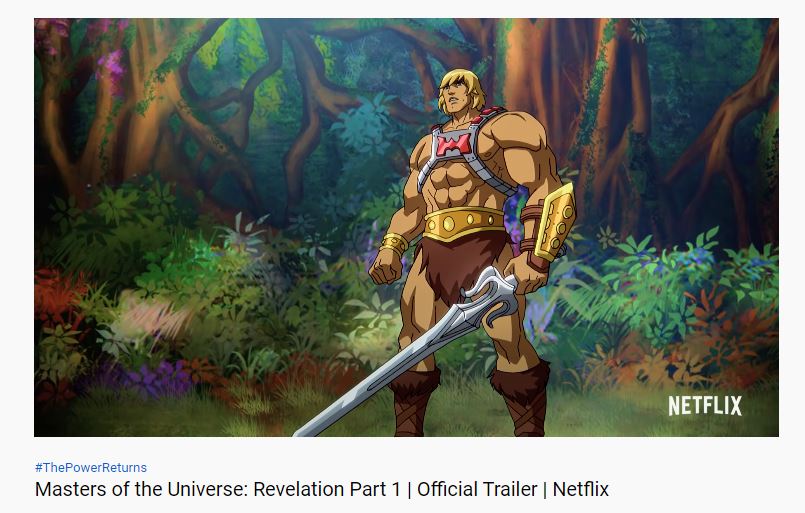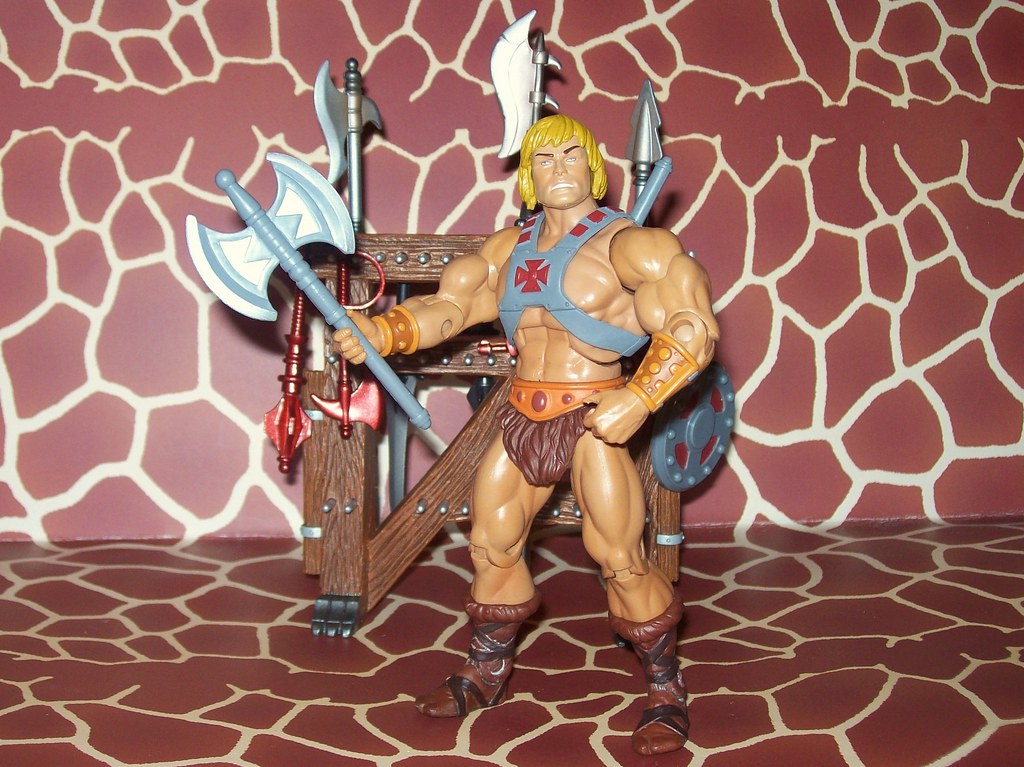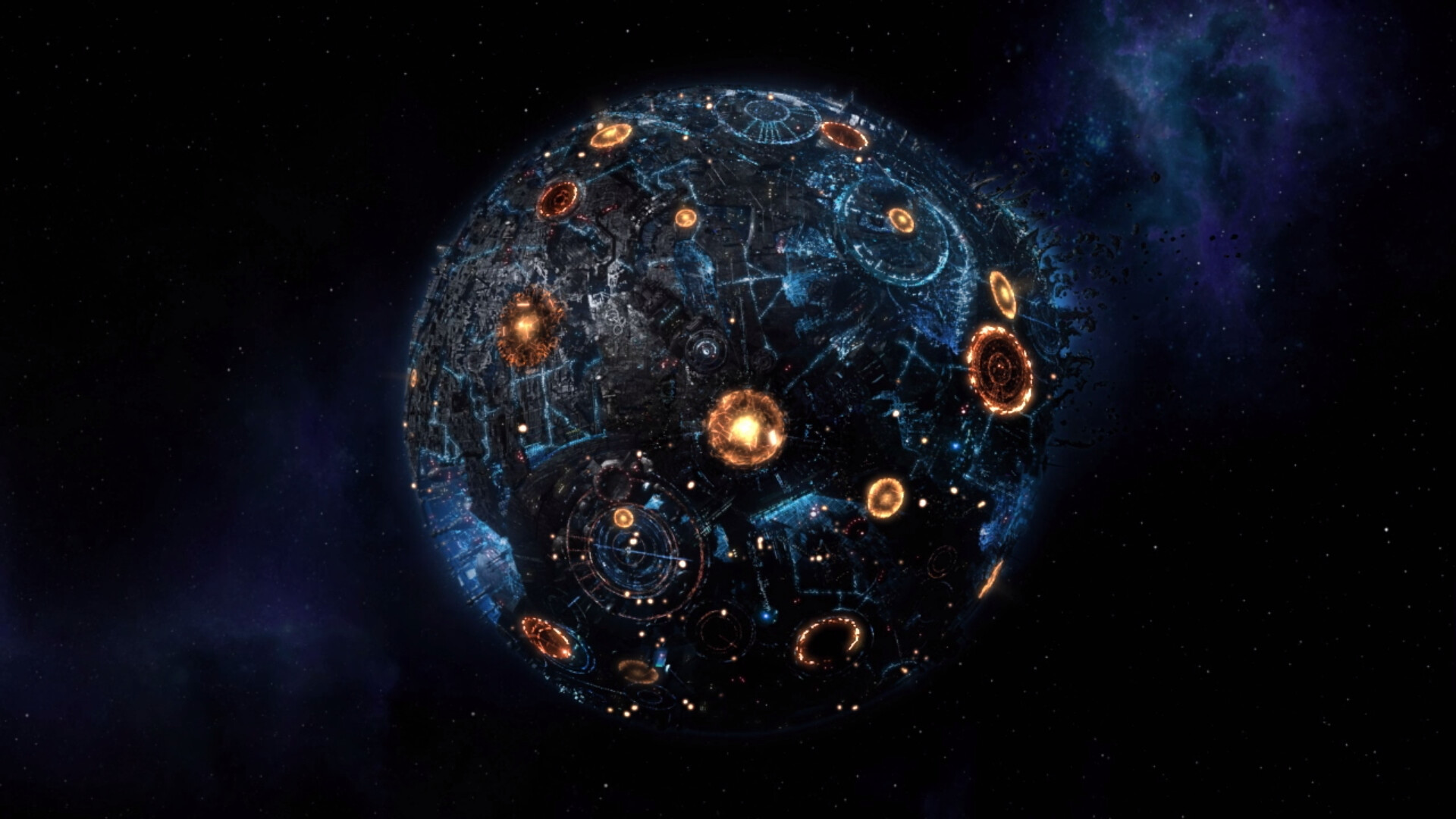The best vintage toys in the world are 80s toys. From Masters of the Universe to My Little Pony these beloved characters will forever have a place in our hearts and in history. Whether you were a collector of Garbage Pail Kids, or you remember falling asleep to the sound of Teddy Ruxpin telling you another fanciful story, you will forever know what it means to have your toys be your whole world, and you will always know what it means to be an 80s kid.
Now we present you with our choices for the best vintage toys from the 80s:
Teddy Ruxpin
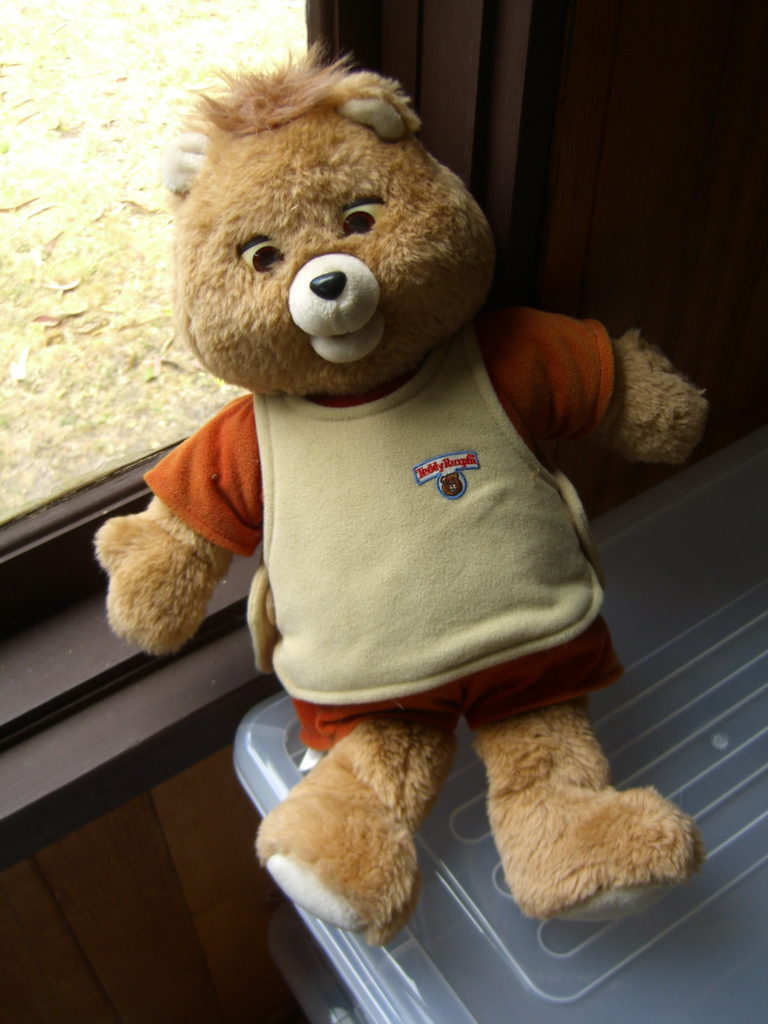
Teddy Ruxpin is a beloved vintage toy plush talking bear who comes with a book and cassette tape. He has golden-brown fur and wears a tan shirt with red sleeves. He is an animated mechanical toy and moves as he talks. Teddy Ruxpin is usually found in a sitting position. The cassette tape he comes with can be put into a cassette deck built in his back that plays audio where he narrates a story. The user can follow along with Teddy Ruxpin has he reads the story out loud with an actual book that comes with the toy. His face is expressive as he moves his mouth and his eyes blink to make it look like he is alive. Teddy Ruxpin has been known to build vocabulary and comprehension skills in his fans. He requires 4 batteries that aren’t included. Teddy Ruxpin was a bestselling toy in 1985 and 1986. This toy was so popular back in the day that it’s making a comeback today. A new Teddy Ruxpin is available who has color LCD eyes and over 40 animations. He can tell multiple stories and sing songs by pressing his hand. Users can follow along with his story or song by downloading the app on their phone or iPad. Additional stories can be bought via in-app purchase.
Care Bears
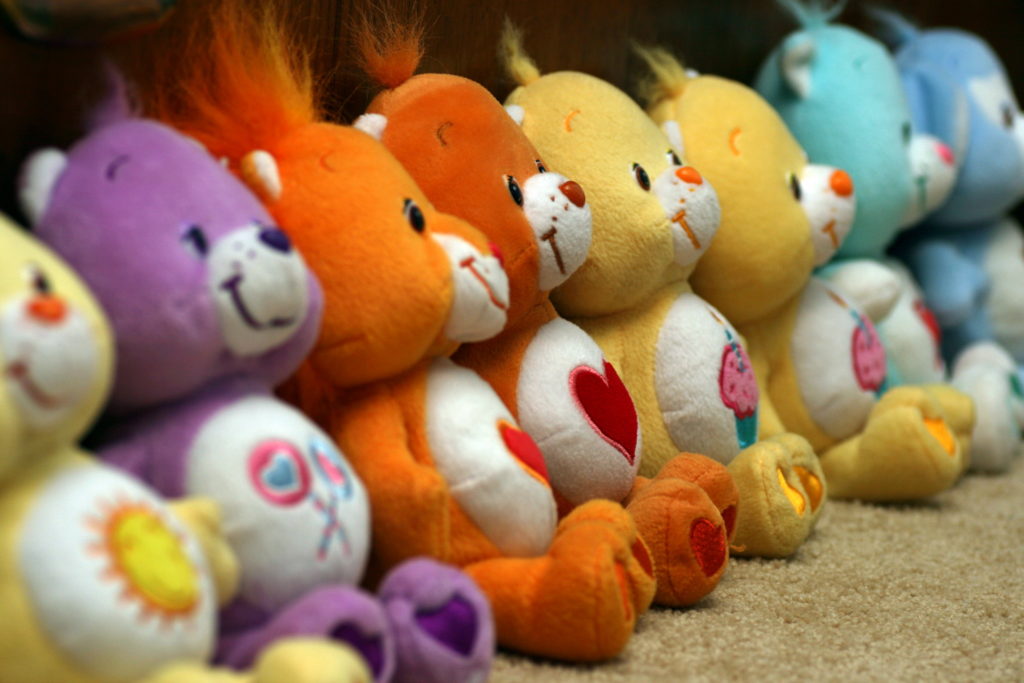
Care Bears are those cute and cuddly bear characters that you’ve probably seen that come in rainbow colors and have symbols on their stomachs. Although they are still prominently in the media today, many young people are unaware Care Bears have been around for decades. The toys were originally created by the American Greetings Cards company. These bears first made their appearance in 1981 by American Greetings Card artist, Elena Kucharik. These characters were an instant hit and quickly took America’s hearts. The Care Bears were made into plush toys at first and eventually got a TV show and movie singing songs and going on Care Bear adventures. The original artist only made 10 bears: Bedtime Bear (moon symbol), Birthday Bear (cupcake symbol), Cheer Bear (rainbow symbol), Friend Bear (two flower symbol), Funshine Bear (sun symbol), Good Luck Bear (four-leaf clover symbol), Grumpy Bear (raincloud symbol), Love-a-lot Bear (pink and white heart symbol), Tenderheart Bear (large red heart symbol), and Wish Bear (shooting star symbol). This is a lot different from the 30-something Care Bears that exist today. The bear characters continued to experience ongoing success in the movie and TV industry.
Multiple films were released in the 1980s and more in the 2000s and even 2010s.
Transformers
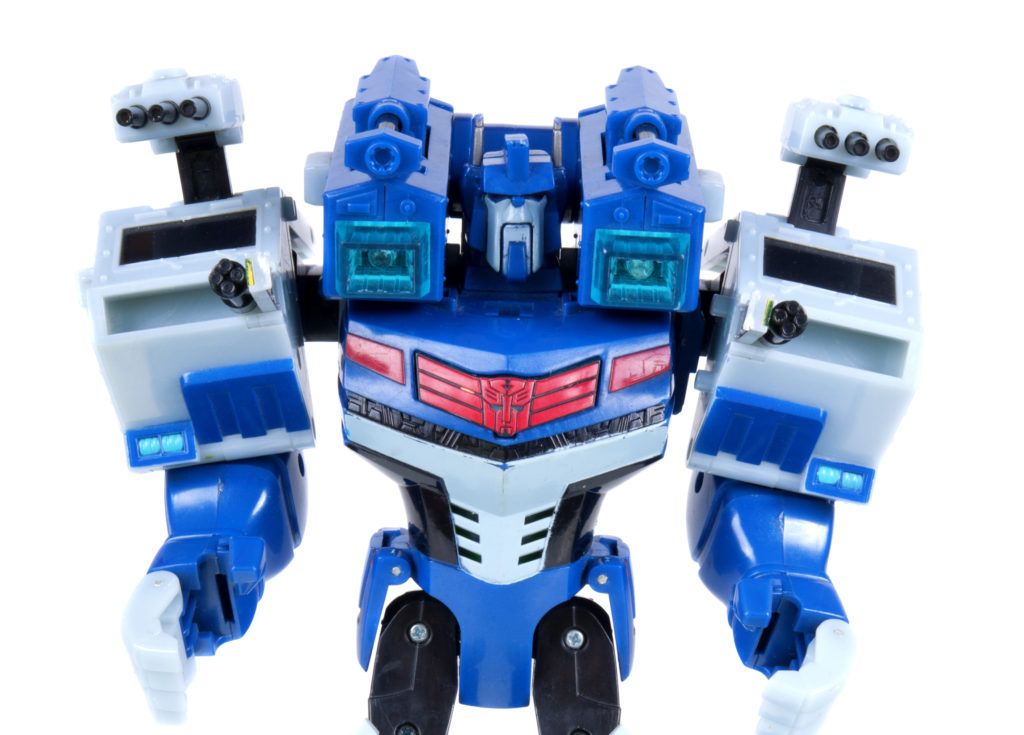
The original Transformers started off as an American animated TV series created by Hasbro Takara that premiered in 1984 and lasted for a little over three years. The story tells of robot superheroes inspired by a Japanese science fiction toy line called Microman, who made its first appearance from 1974 to 1984. What started as a miniseries of just three episodes turned out to be an instant hit and was followed by 4 seasons (100 episodes) and a feature film starring the Transformers. It was in these films where Optimus Prime was introduced, leading the Autobots and working against the Megatron’s Decepticons as they searched for a new energy source and come across the planet Earth. The feature film that was released in 1986 was meant to bridge a gap between seasons 2 and 3, which made way for a brand new line of characters including Hot Rod as the new Autobot leader Rodimus Prime. This franchise inspired the Transformers film series, a six-film series that was created in the late 2000s and went through the 2010s. It has also been a popular subject matter for toys both back when the franchise was created and is still a hot topic today. Some examples of toys include cars that can be configured into robots or trucks that can flip outward and transform into an Autobot.
Pound Puppies
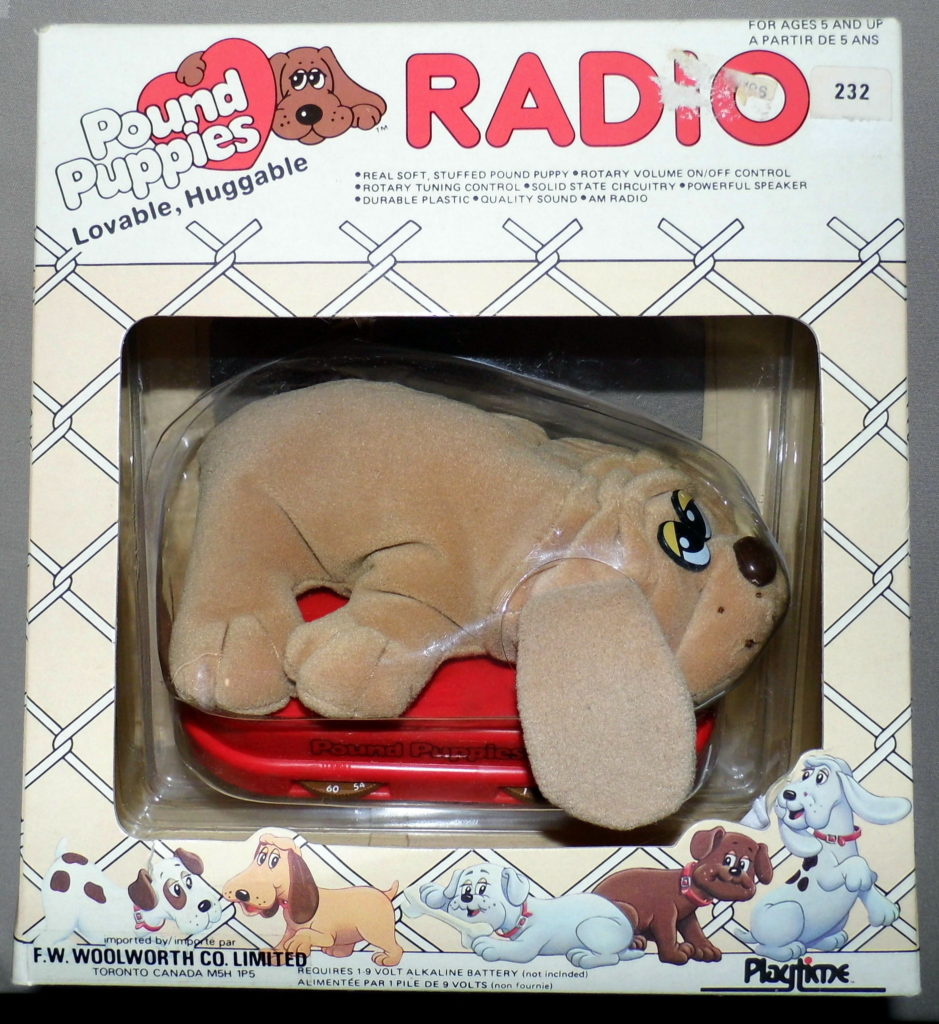
Have you ever wanted to adopt a puppy? Pound Puppies make it easy. Pound Puppies first originated from a toy line created by Tonka. This inspired the 1985 TV special and its sequel, an animated American TV series by Hanna-Barbera Productions in 1986. This comedy-adventure series includes stories of puppy adopting, making friends, and stopping villainous characters on the way. The show lasted two seasons, each containing thirteen episodes. As for the toys from the ’80s, these popular pups came with an adoption certificate and a name tag to make things official! The classic Pound Puppies were plush and available for purchase, coming in colors like grey, white with brown spots, light brown with dark brown spots, beige with brown spots, beige, and red with black spots. In addition to the classic Pound Puppies, there are newborns available for adoption. These smaller versions wear diapers and come in dark brown, cream with brown spots, black, white with black spots, light brown, and grey with black spots. Both classic and newborns have ears that are floppy and come in normal and large sizes. They all have red collars and large, tired-looking eyes. Today, an adaptation of the Pound Puppies series exists and was created in the 2010s. Toys are available that mimic the real toys that were available in the 1980s for an authentic feel.
Cabbage Patch Kids
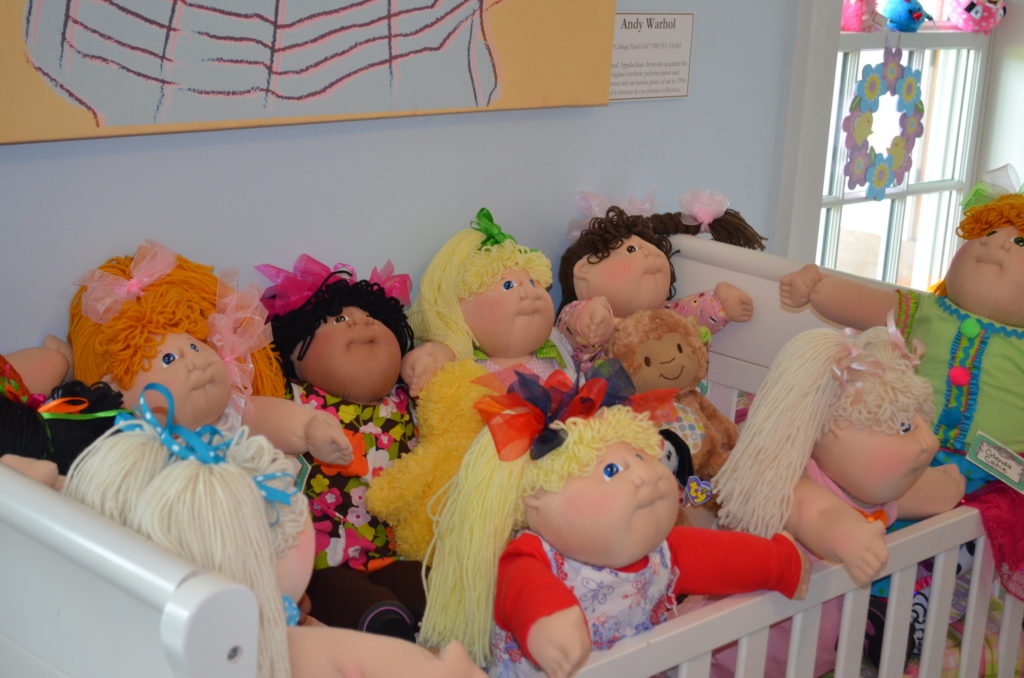
Cabbage Patch Kids is a doll brand and first made an appearance in 1978 known as The Little People. The first doll was created by Xavier Roberts, an art student who was experimenting with soft-sculptures and needle molding. It was only in 1982 when The Little People were rebranded and named what they are commonly known as today: Cabbage Patch Kids. You’ve probably already heard of Cabbage Patch Kids due to it being one of the longest-running doll franchises in the country. They have reached the toy industry with more than just dolls, however. Their merchandise spans from products such as animated cartoons, record albums, and board games. These dolls have a signature look of sculpted faces with large cheeks and a small face. Their bodies also resemble the same bubbly shape their heads do. There are different assortments of Cabbage Patch Kids that come in four different sizes. Some are newborn infant-like dolls whereas others look like toddler age. This goes up to dolls that resemble young children who could walk. There is even an option of getting twins. They come in a variety of different skin colors, eye colors, and hair colors. There are so many clothes to buy that will fit your Cabbage Patch Kid. It is truly a brand that doesn’t look like it has stopped in its success since the ’80s.
Speak & Spell
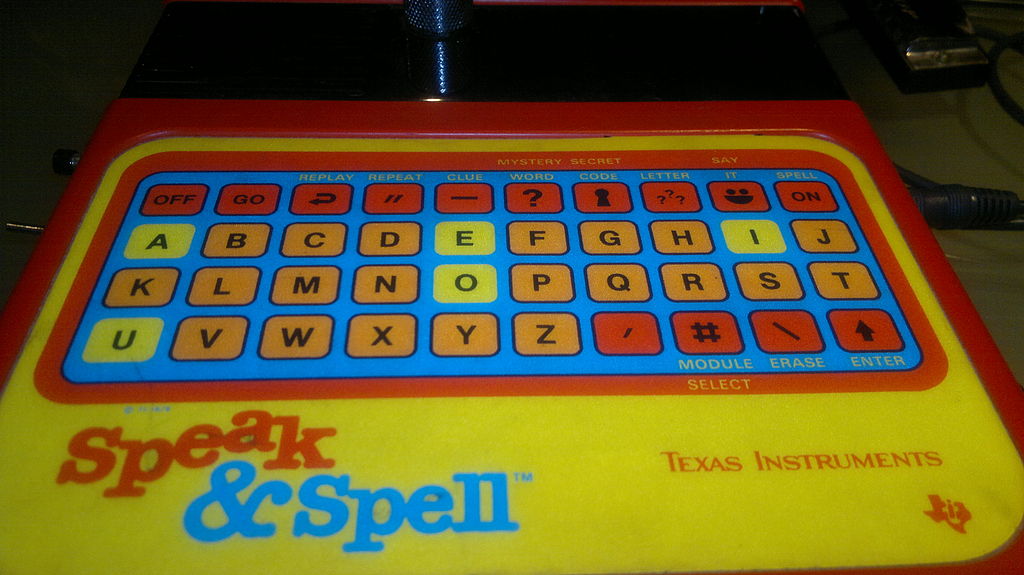
Speak & Spell is a Texas Instruments electronic device that helps your child learn how to spell and pronounce commonly misspelled words correctly. It was one of the earliest computerized learning systems for kids. The device is a red hand-held toy that can fit in a child’s lap that has a keyboard and a screen that displays the words. Snap-in modules or interchangeable game cartridges each have hundreds of words to speak and spell. The original game was designed to be for children ages 7 and up. It was such an iconic toy that it was released in 9 different countries and available in 7 different languages, with regional variations for each kind. There were also redesign aspects such as the keyboard function of the toy. Originally it had raised buttons that showed letters alphabetically. Then for their redesign in 1980, they implemented a flat touch-sensitive membrane keyboard. Speak & Read and Speak & Math were additional educational toys that could be purchased as a part of the three-part Speak series. The same company that created the first Speak & Spell called Basic Fun created a modern version in 2019 that is still available for purchase today. One of the main new features of the new Speak & Spell is a liquid crystal display (LCD) screen to show the words instead of a vacuum fluorescent display (VFD) screen in the earlier versions. The 2019 design still looks almost the same as the 80’s one besides the elimination of the removable cartridges from the back of the device.
Lite-Brite
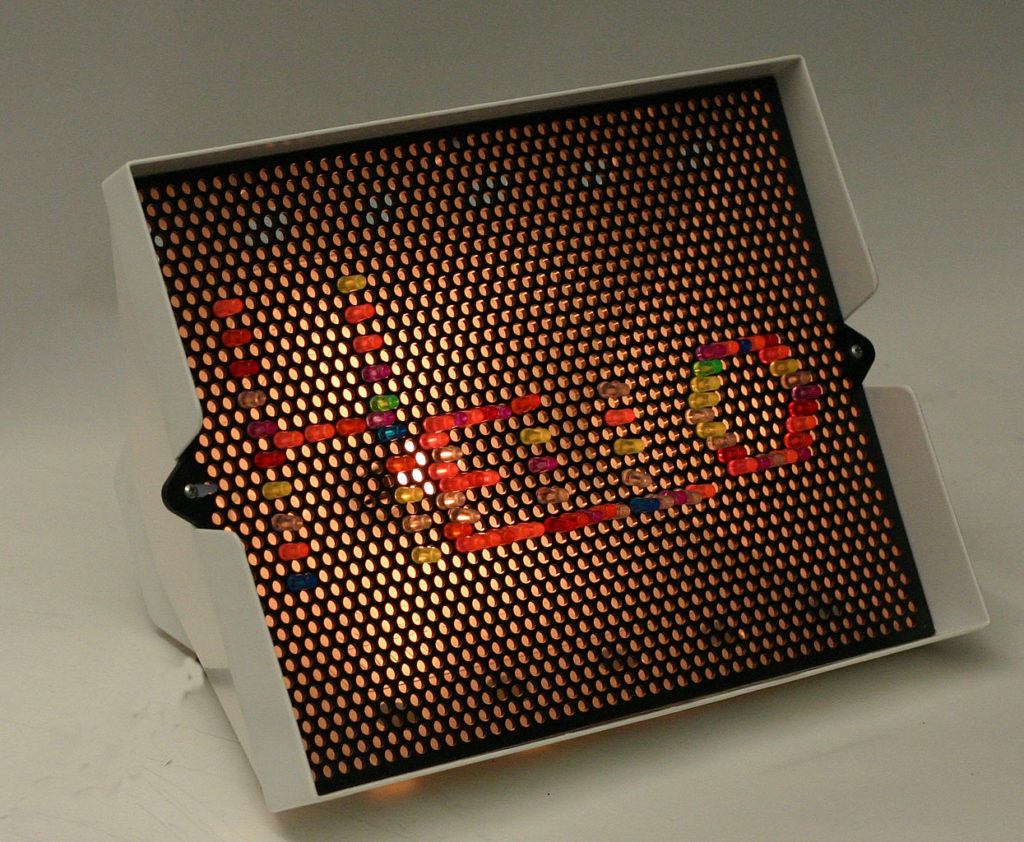
Lite-Brite toys were created by Joseph M. Burck, a game designer who licensed the toy to Hasbro company. They first surfaced in 1967 but gained much of its popularity in the ’80s. Although they are still available today, many people consider these vintage toys. Lite-Brite toys consist of a box-like structure that contains a light inside. It is covered by a dark sheet that contains many holes for pegs to stick through. Small pegs of different colors can create a lit picture by either using template guides or freeform imaging. The peg colors come in red, blue, orange, white, green, yellow, pink, and purple. Hasbro sold more refill pegs of different color assortments. There were also templates so kids could create their favorite TV or movie characters of the ’80s. Lite-Brite made a short comeback with technology in 2010 when stop-motion videos became popular. The David Crowder band collected over seven hundred Lite-Brite pegs to make the first billboards Lite-Brite motion picture music video. Their record SMS, tells the story of rising from grief through the color and wonder of Lite-Brite sets. In later years Lite-Brite began to make brand-specific kits for characters like Harry Potter in an attempt to stay relevant.
Viewmaster
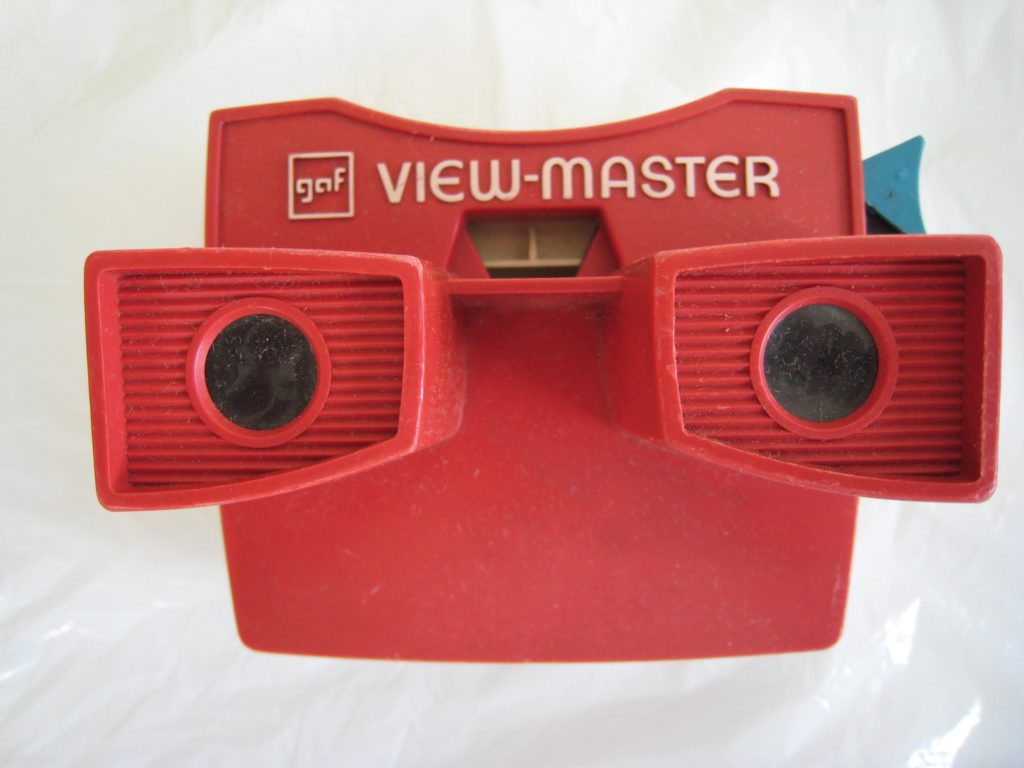
If you go to an 80’s themed party, you’ll probably find a few Viewmaster toys lying around. These iconic toys from the ’80s resembled bright red binoculars. They came complete with a finger-sized lever attached to the side of it. They came with Viewmaster reels, which were disks made of cardboard and stereoscopic 3D pairs of small transparent color photographs on film. You would insert your Viewmaster reel into the Viewmaster, make sure it was lined up correctly, and look through it to see the picture. Pulling the lever with your finger would spin the disc and go to the next photograph on the reel. Despite it being a nostalgic toy from the ’80s, the Viewmaster was created much earlier in 1939. It was a toy that was initially intended to be used by all ages. As time went on and the product was expanded, both the Viewmaster and the reels started being tailored more toward an audience of children. Some themed reels included safari adventures, marine life discovery, endangered species, age of the dinosaurs, Yellowstone National Park, and more. Viewasters are still made today and include branded reels like Disney, Transformer, and Barbie. The updated viewmaster often come with storylines told through the reels.
Strawberry Shortcake
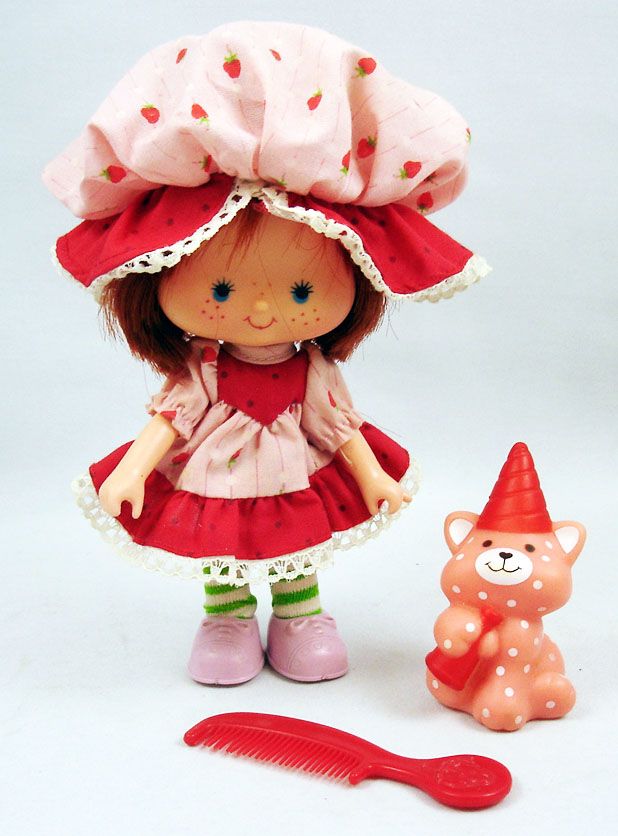
Strawberry Shortcake is a cartoon character of a famous franchise. The character was first seen in a greeting card by the American Greetings company. Strawberry Shortcake was originally known as Girl with a Daisy. She first appeared on a greeting card in 1973 by artist Barbi Sargent. They accredited the character’s popularity to the cute appearance and the strawberries in the picture. The artist created four more cards and named her Strawberry Shortcake in the late ’70s. She was an instant hit. The franchise was then incorporated into toys, dolls, posters, and movies. She also starred in a 1980 animated TV special by Romeo Muller, The World of Strawberry Shortcake. The premise is about Strawberry Shortcake, a young six-year-old girl. She lives in a shortcake house in a fictional place called Strawberryland. Her original friends were named Huckleberry Pie, Blueberry Muffin, Raspberry Tart, Plum Puddin’, and toddler Apple Dumplin’. Many more characters were added in later years, but Strawberry Shortcake remained one of the most popular cartoon characters of the ’80s. Her popular collectibles now include stamps, books, dolls, and scratch-and-sniff stickers. The most popular of the toy franchise included a set of dolls. The dolls featured Shortcake and each of her friends with their own distinct smells such as Strawberry Shortcake, Blueberry, and more.
Easy-Bake-Oven
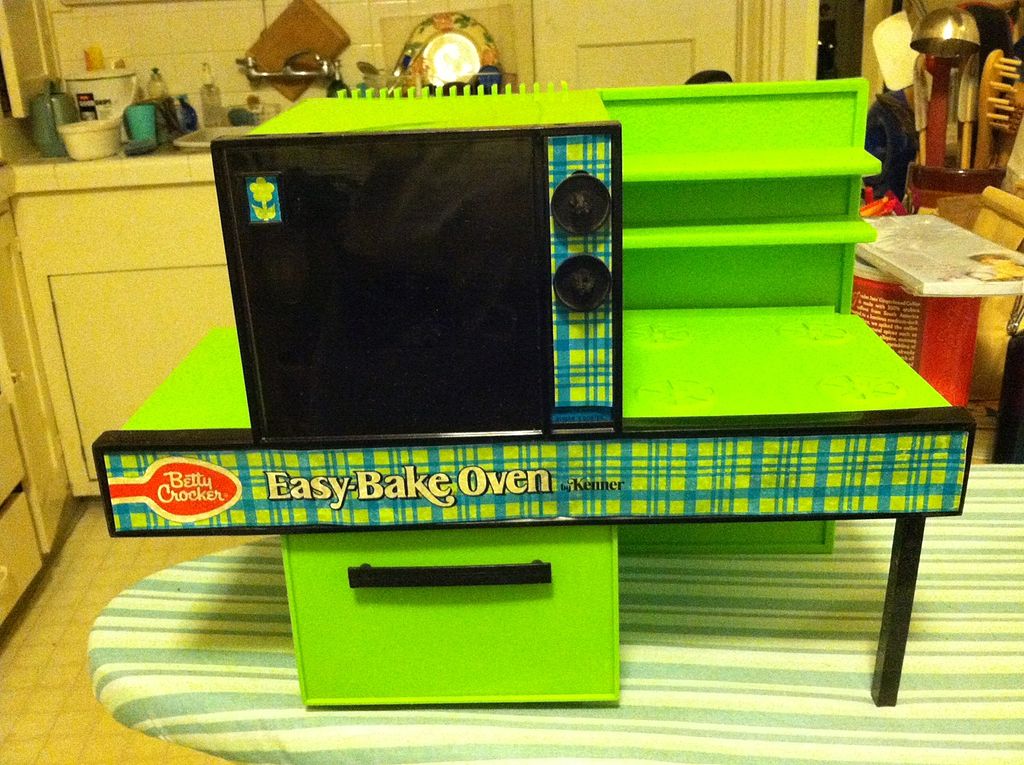
Easy-Bake-Ovens were some of the most popular toys in the ’80s. These ovens were made for children, believe it or not. The oven would plug into a power outlet and it would pre-heat just like a real one. However, the actual part of the oven that heated was essentially blocked off and prevented a child from touching it by having the container of the oven be a lot larger than the actual heat system itself and therefore the outside of the oven would not be hot or burn. Its heat source is a pair of incandescent light bulbs and the oven comes with cake mix packets, small round pans, and a long plastic utensil that helps entry and removal from the oven without touching the heat source. Additional cake mixes can be bought separately. The process includes mixing the cake mix with water and then using the utensil to push the cake pan containing the mix through the oven slot until it reaches the middle of the oven near the heat source. After the cake bakes, the same utensil can be used to push the cake pan through the slot and to the other side where it can be cooled and removed from the oven. These fun toys were first introduced in 1963 and continued to be a success throughout the ’80s and are still available for purchase today.
ColorForms
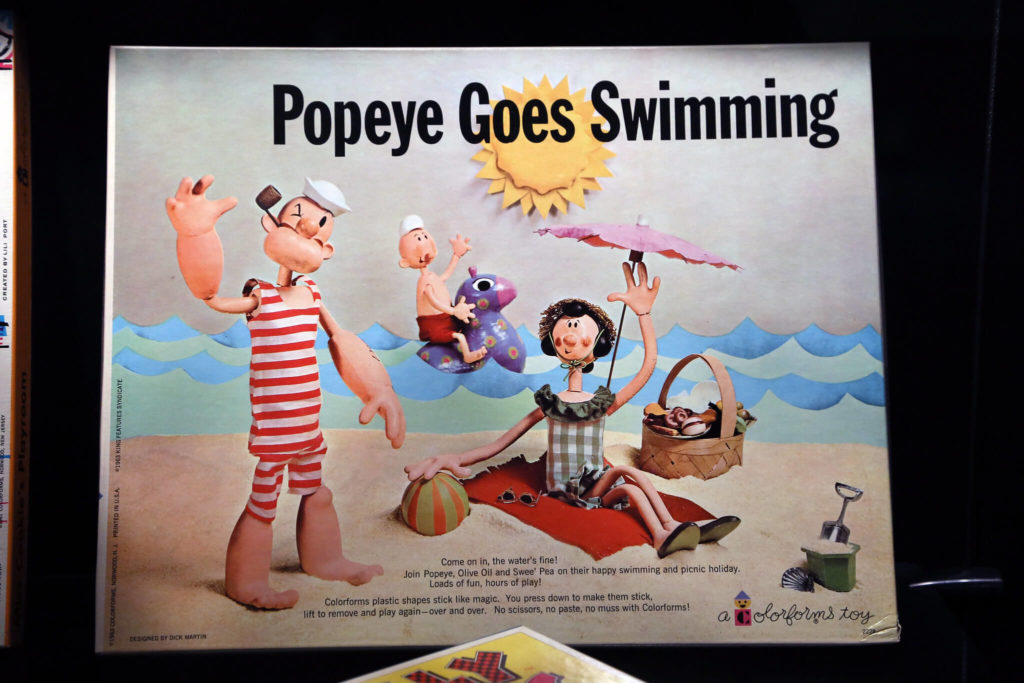
ColorForms were small vinyl sheet cut-outs of shapes and characters. They could be affixed onto a smooth surface with no use of adhesives. They could be played with and repositioned an infinite amount of times. The first ColorForms were simple shapes that would cling to a black or white background. It then evolved to show scenes such as an empty living room in a house and have character cut-outs to play house with. It wasn’t just limited to playsets either. Games and puzzle ColorForms could be created including jigsaws or other similar things. It is estimated that more than a billion ColorForm sets have been sold worldwide. ColorForms vintage toys were created by Harry and Patricia Kislevitz in 1951. They were both art students and wanted to explore painting, but uncomfortable with the high price of art supplies. In 1951, they bought rolls of bright vinyl, cut out designs and hung them on the walls of their bathroom. Extra vinyl and scissors were left out for guests to add to their version. When their friends became absorbed with the multitude of colors, and artistic possibilities, Harry and Patricia knew that they were onto something. ColorForm was designed to be used for all ages and is still a favorite among collectors.
Micro Machines
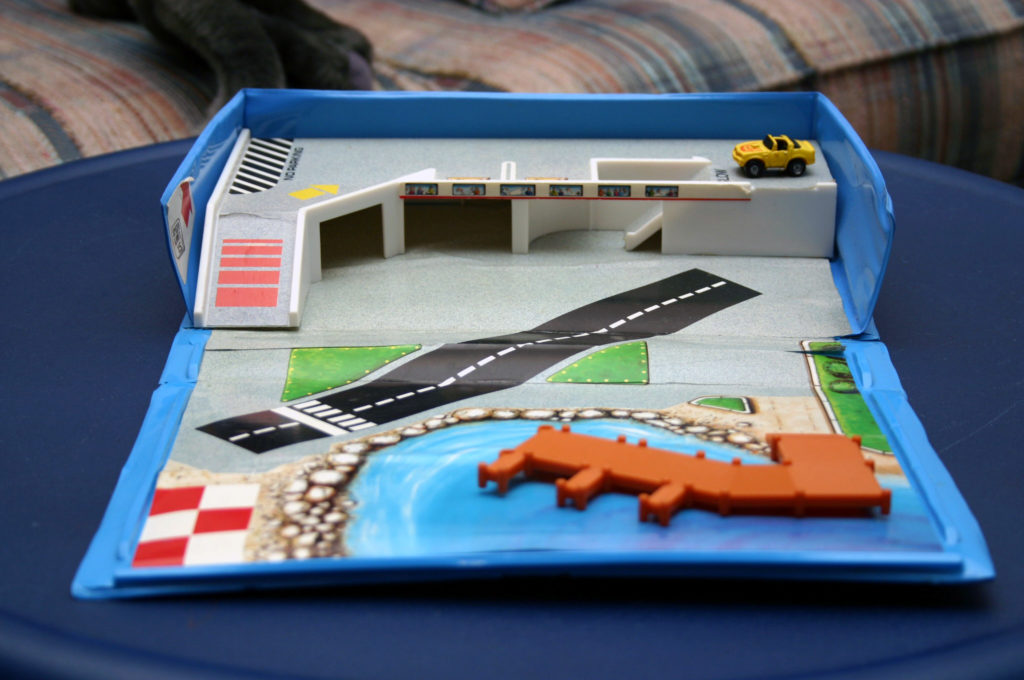
Micro Machines (also known as Micros) was a toy line created by Clemens V. Hedeen & Patti Jo Hedeen as part of the Galoob company in the ’80s. It was among some of the most popular toy car lines in the US, ranking next to Hot Wheels, Matchbox, and Majorette in sales. The toys included metal and plastic model cars, trucks, trains, emergency vehicles, tanks, boats, planes, helicopters, and motorcycles. Their famous slogan from 1987 was: “Remember if it doesn’t say Micro Machines, it’s not the real thing!” They were prominent even in popular media, where Micro Machines were featured in the 1990 Christmas movie, Home Alone, where they were used as a booby trap for the burglars. The Micro Machines collection was known primarily for cars but also had several playsets including 1991’s fold-out Super Van City. Licensed characters were often folded open, with miniature characters and vehicles that were interactive with the playset environment. Micro Machines also had many unusual features, including color-changing cars, private eyes, which allowed a visitor to peek into a vehicle and see a picture of the contents. The Micro Machines Insiders series is one of the Micro Machines product lines. The Insiders series was incredibly popular in the late 1980s and early 1990s. It featured a small vehicle inside the standard size Micro Machine. The body and chassis of the larger vehicle were joined by a hinge; opening the smaller door showed that it was a different model of car.
Masters of the Universe
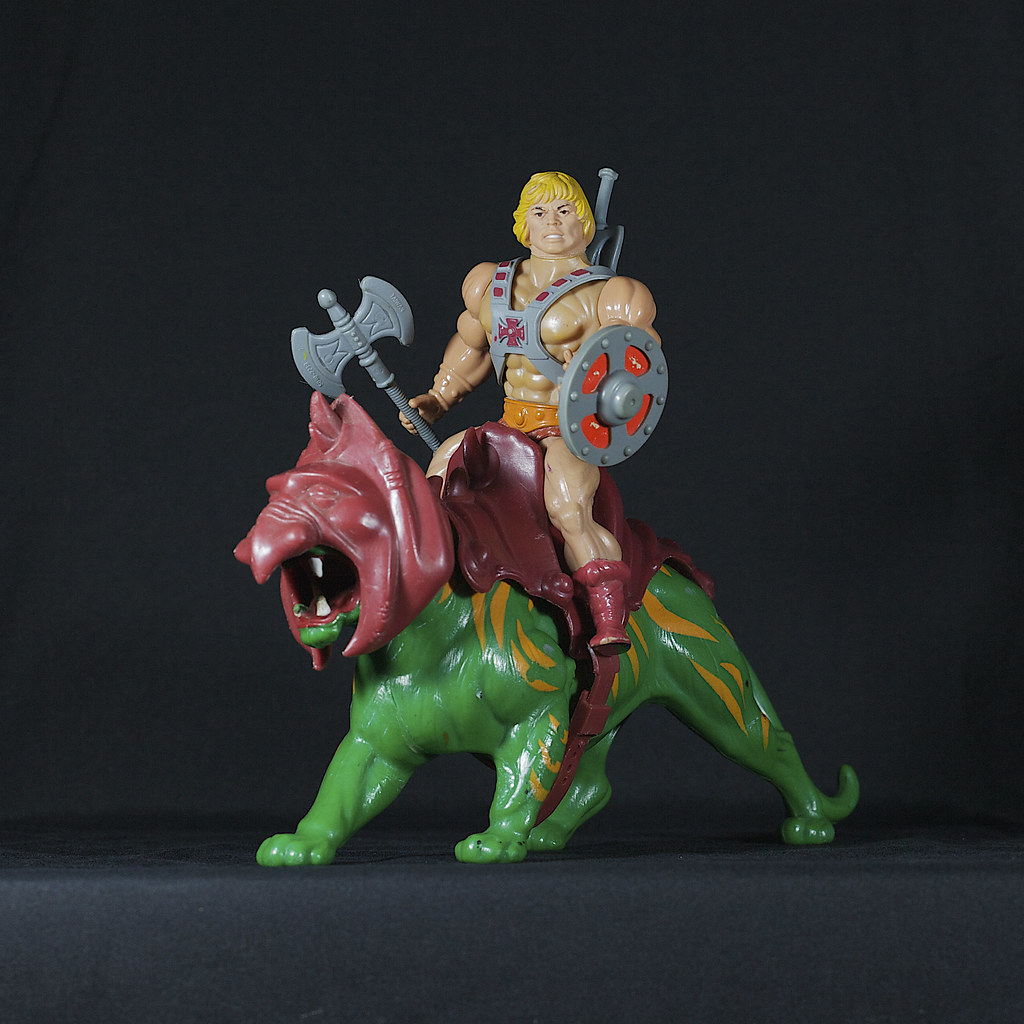
Masters of the Universe is a toy series made by Mattel whose theme surrounds swords and sorcery. It is sometimes referred to as He-Man and the Masters of the Universe. He-Man is called the most powerful man in the universe and fights Skeletor, who is a sorcerer. Their conflict takes place on the planet Eternia. This franchise has been incredibly successful leading to TV series, comics, video games, books, magazines, and movies. In 1982, Mattel released the first toy in the Masters of the Universe series, a 5.5-inch figure. The series began to take shape through the minicomics that were released along with the toys. After this, the series was followed by several children’s books and issues of DC Comics; but it is now best known for its animated series, He-Man and the Masters of the Universe. Since its inception, Masters of the Universe has usually focused on the two main characters–the blond, muscular hero He-Man and his nemesis, the evil sorcerer Skeletor. Children’s books, magazines, comics, read-along records/cassette tapes, and other merchandise were also released worldwide during this period, most of it based on the Filmation He-Man and She-Ra series.
Spirograph
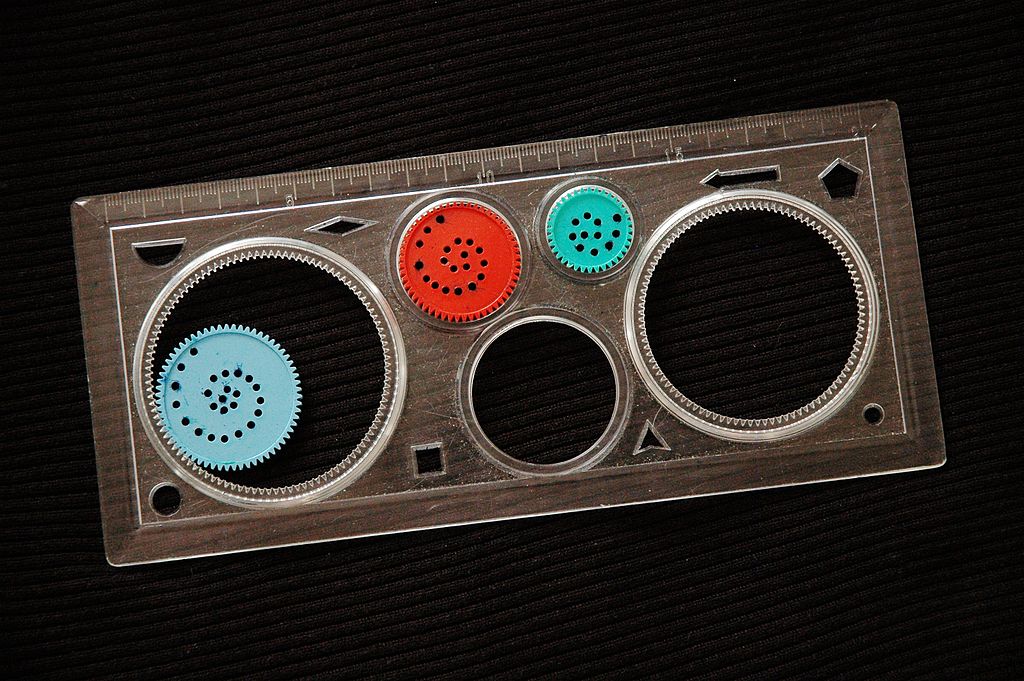
Spirograph is a device that will help you draw geometrically using mathematical roulette curves called hypotrochoids and epitrochoids. It was invented by Denys Fisher and was released in 1965 by the Denys Fisher company. The Denys Fisher company was then taken over by Hasbro Inc. in 1998 and the name Spirograph was trademarked. In 2013, Spirograph was relaunched by Kahootz Toys. Toys that resemble gears have been available since 1908 when a toy called the Marvelous Wondergraph appeared in a Sears catalog. In 1913, an article on how to build a Wondergraph drawing machine appeared in the Boys Mechanic magazine. The toy was invented by British engineer Denys Fisher in 1962-63 using drawing machines made from Meccano pieces. Fisher showed off his spirograph at the 1965 Nuremberg Toy Fair. The Spirograph has seen a recent growth in popularity again with artists who like drawing to relax, but the original Spirograph can be found on amazon.
Star Wars
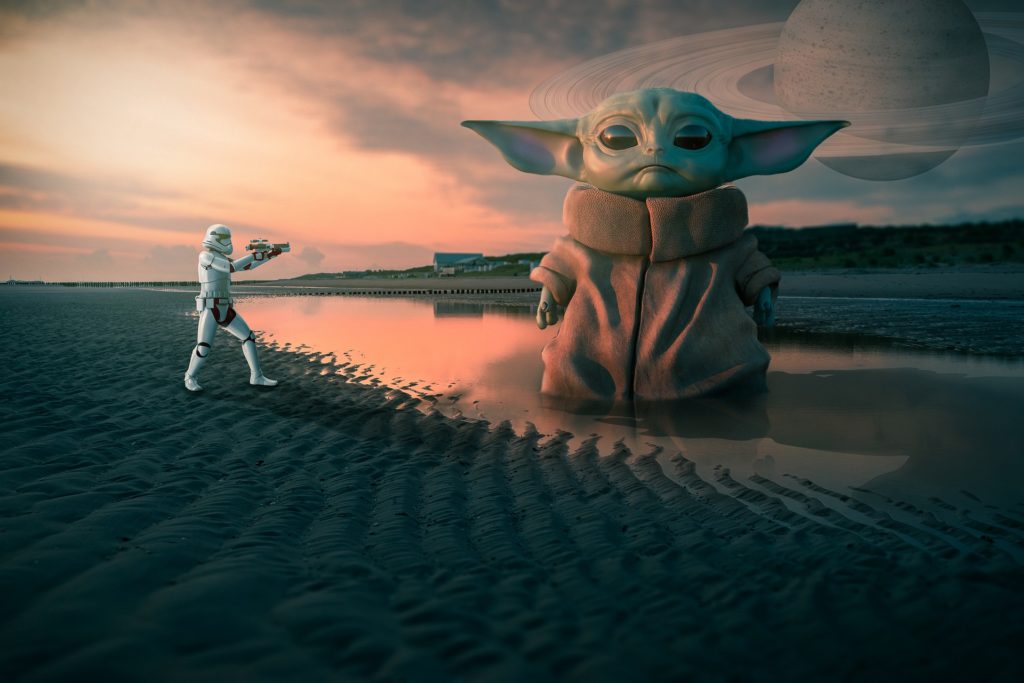
No other movie has rivaled Star Wars when it involves tie-in entertainment. Since the movie’s release, almost every character, vehicle, and location from the movie has been turned into a figure or playset, and both kids and adults have bought as many figures as they can afford. The Slave-1 Boba Fetta Spaceship from 1981 came with several removable parts, including Han Solo in carbonite, a tinted canopy, stabilizer fins, and a cargo ramp. Star Wars held everything from collectible cards to collectible coins that are still worth hundreds today if found in mint condition.
Etch A Sketch
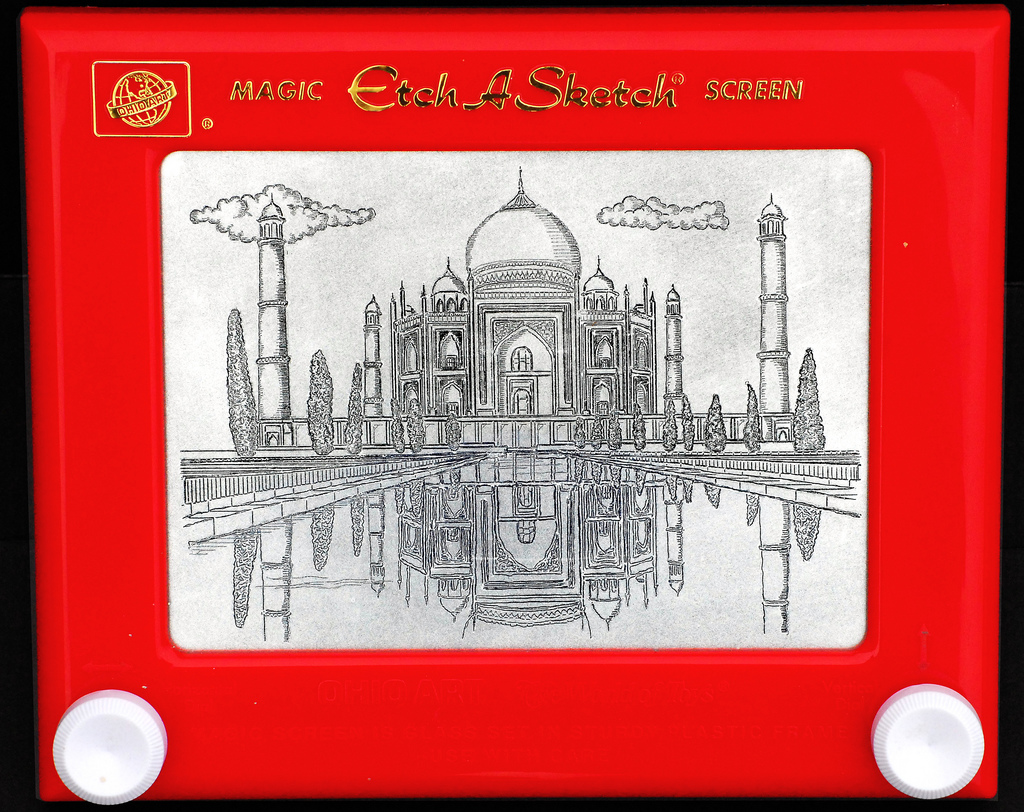
Etch A sketch was originally designed in the 1950s, but it wasn’t produced until the 1960s at $2.99. Later, The Etch a Sketch Animator premiered in a smaller form in the 1980s that featured a low-resolution dot matrix display and used two knobs for drawing, like a regular Etch a Sketch, with several buttons to change the drawings. The first price was $89.99. The smaller version even contained speakers that made static noises as the buttons turned. It could store up 12 pictures. In 1988, Ohio Art introduced a new version of the Etch a Sketch Animator called the Etch a Sketch 2000. This new design looked more like a laptop with a much larger screen, its biggest change was the removal of the knobs which was replaced with mouse pads. Older fans of the Etch a Sketch still seem to prefer the original design from the early 1980s though. The Etch a Sketch is still available for sale in its original form, but the 1980’s version in original packaging is now considered a collectible toy among hobbyist
Big Wheels
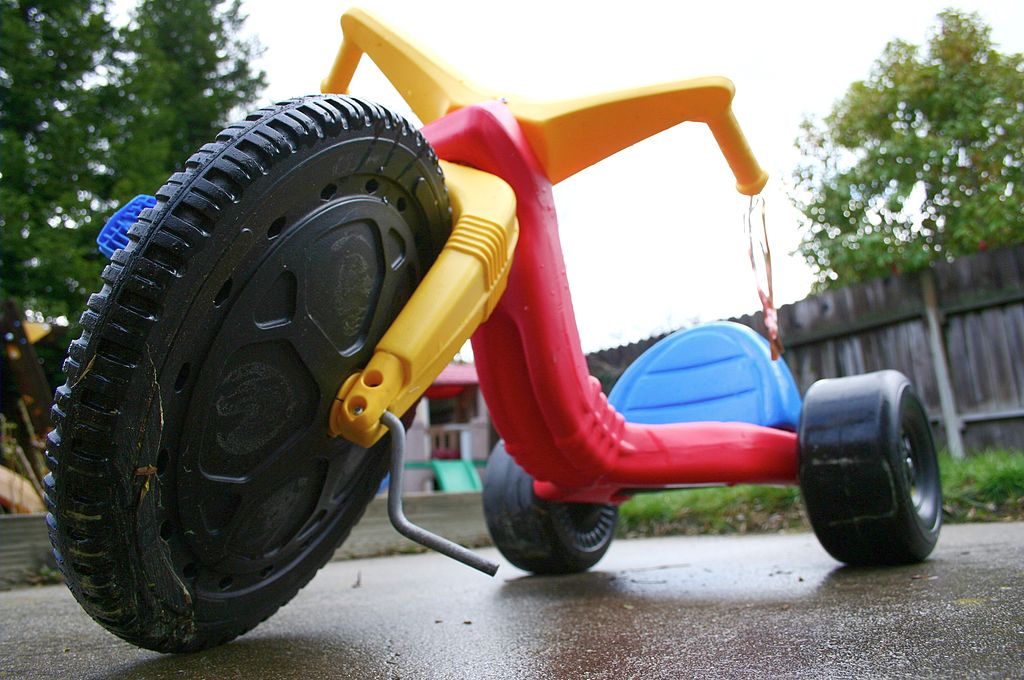
Big Wheels is a type of low riding tricycle made originally made out of plastic in the early 1970s for kids to peddle around in their yard, however, the success of the tricycle didn’t take off until the early 1980’s when it became more customizable. It has a bigger front wheel than the other types. It was introduced by Louis Marx and Company first in the 1960s. Originally, it was a trademark brand name, but in the 1980s any toy that matched the tricycle look became known as Big Wheels, no matter who made it. Today’s children ride in style in the sleek and racy, brightly-colored, low-slung plastic that looks like anything from Harley’s to jeep wranglers. 1980’s version of the tricycles were made into self-peddling bikes, but more popular brands today include motorized rides that even honk and light up and charge by a battery.
Monchhichi
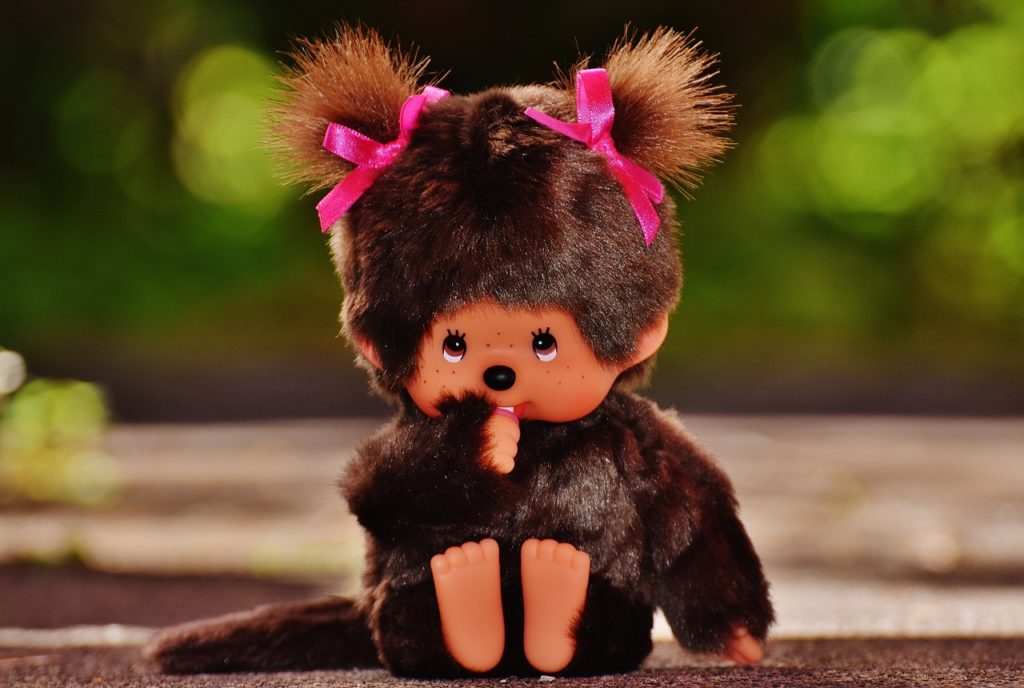
The first version of Monchhichi was released in Japan in 1974 and people were obsessed with it. Kids could not stop talking about it. The name Mon means mine in French. The last half of the name, Chichi, came from the sound a baby makes when using a pacifier. Monchichi’s first dolls were a pair of twins, one male, and one female, with furry little bodies and human-looking faces, which are almost the same as they are today. In 1980, the dolls were designed to be sucking their thumbs, similar to the children who played with them. In 1980, experts began asking for the dolls to be changed to include a pacifier, fearing that the habit of sucking their thumbs would encourage children to suck their thumbs later in life. In 1985, they changed the blue-eyed Monchichi into a brown-eyed monkey but otherwise remained the same with no major changes to the size or shape. The popularity of the toy shot up in the coming years and allowed the toys to expand from West Germany to Austria and even further as children fell in love with the toy and remains a go-to toy today.
G.I. Joe
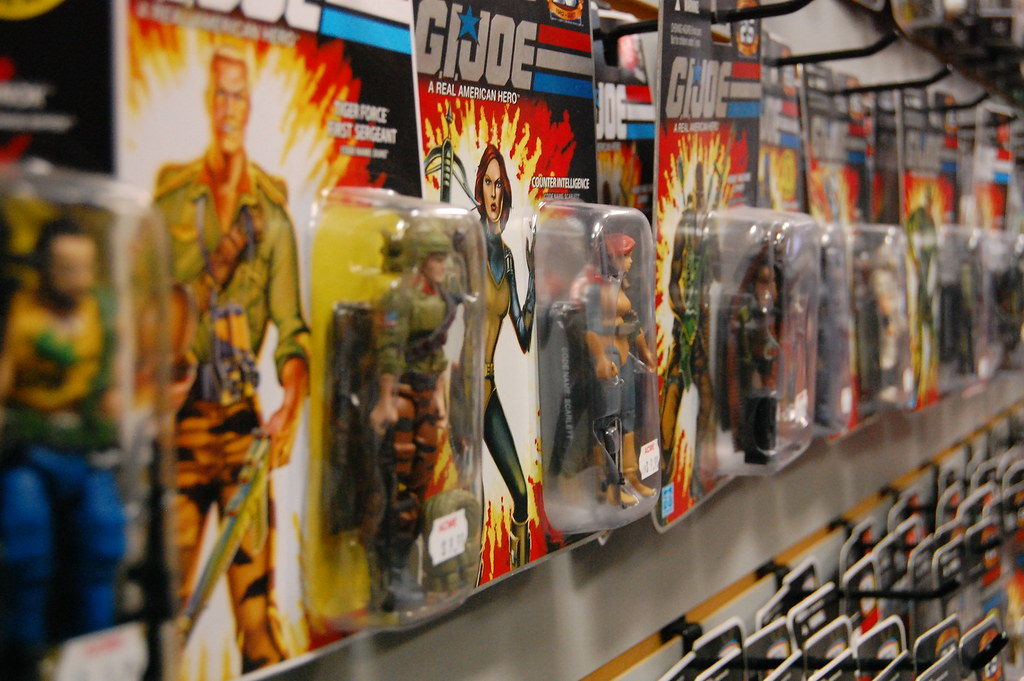
Before the re-launch of the series in 1982, Larry Hama was developing an idea for a new comic book called Fury Force, which he hoped would become an ongoing series for Marvel Comics.
Shooter had been asked to work on the Joe project because of his military background, and the Fury concept was used for the project. Shooter suggested to Hasbro that G.I. Joe should be the team name and that they should fight criminals. Marvel also added female Joes into the toy line and included them with the cars because Hasbro was worried that they wouldn’t sell. Aside from the doll, G.I. Joe toys also included cars and planes based on the 1980’s military technology. A few of these are the G.I. Joe Skystriker XP-14F fighter aircraft, based on the F-14 Tomcat; Cobra Rattler, which looks like the A-10 Thunderbolt II; Dragonfly attack helicopter, which looks like the Bell AH-1 Cobra; the Cobra Night Raven S3P, based on the Blackbird SR-71; and the M551 Sheridan – a copy of the real-life version.
Madballs
Madballs were a type of toy that was made for younger children. Each toy had a different character name and was designed with over-the-top humor for kids. The toy line grew into a franchise with an animated television series, comic books, and a video game later. The toys were rubber or foam collectible bouncing balls with grotesque faces and designs which had a fascination particularly on the part of boys; however, the toys only sold well as a fad. There were two series of the original Madballs collectible toys. Each series consisted of eight balls. There was also a special collection of Super Madballs, a larger version of the original toy. The Super Madballs were shaped like sports balls, such as the American Football-shaped Terror, the soccer-ball-shaped Goal Eater, and the basketball-shaped Foul Shot. Some of the toys even featured monster villains such as Frankenstein and Zombies. Due to the popularity of the toys, similar products were made but never reached the same success. Names of the mock series include blurp balls, and spit balls. Some versions of the toys can still be found today online.
The Smurfs
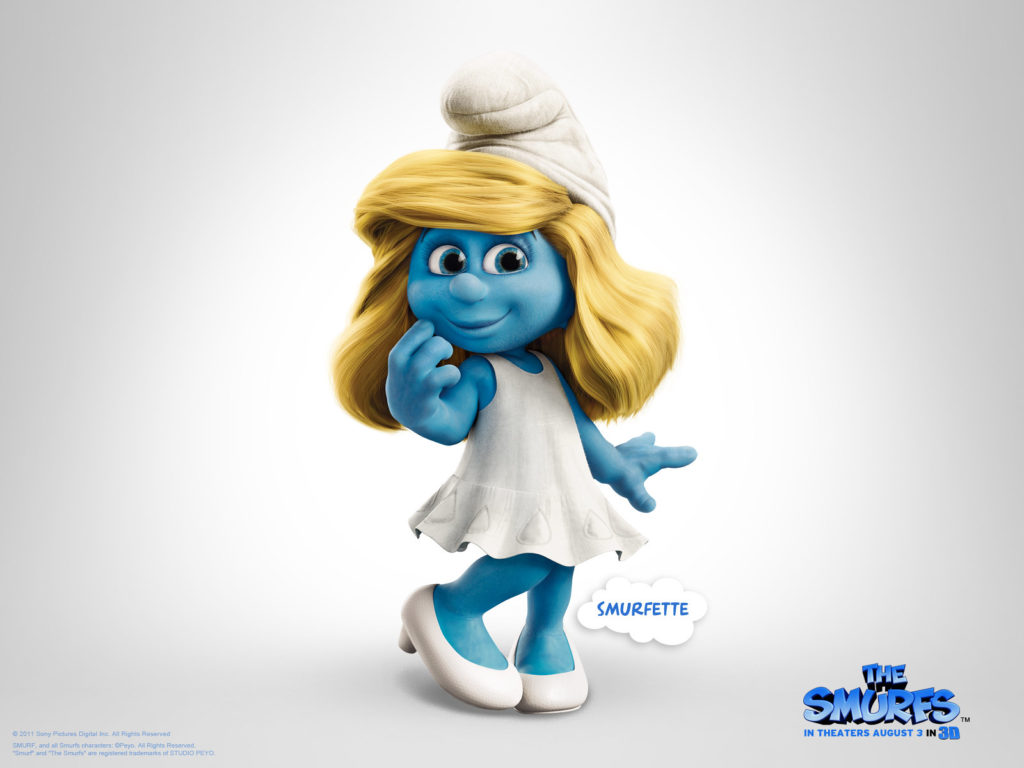
The Smurfs was a Saturday morning cartoon on NBC. It ran from 1981 to 1989. The series was about a group of small characters called the Smurfs who lived in mushrooms in the forest. The lives of the little blue Smurfs would be perfectly fine if not for the evil wizard, Gargamel, and his evil cat, Azrael, who wanted to kill the Smurfs. Dupuis, the editor of the Smurf comics, first made Smurf figurines in 1959. There were many Smurfs toys made in the 1980s. You could get action figures, stickers, cars, puzzles, comics, lunchboxes, TV trays, and so much more.
The first was a series of three figures, five centimeters tall (Papa, Normal and Angry). In the following decade, there were several larger figures, but these were only sold in French- and Dutch-speaking countries. The popularity of the Smurfs in Belgium and Germany has never ceased. Smurf collecting is now a popular hobby for all ages, everywhere. 400 different figures have been produced so far. Only in two years since 1969 (1991 and 1998) have there been no new Smurfs produced; Schleich makes eight new Smurfs per year; over 300 million have been sold.
Barbie
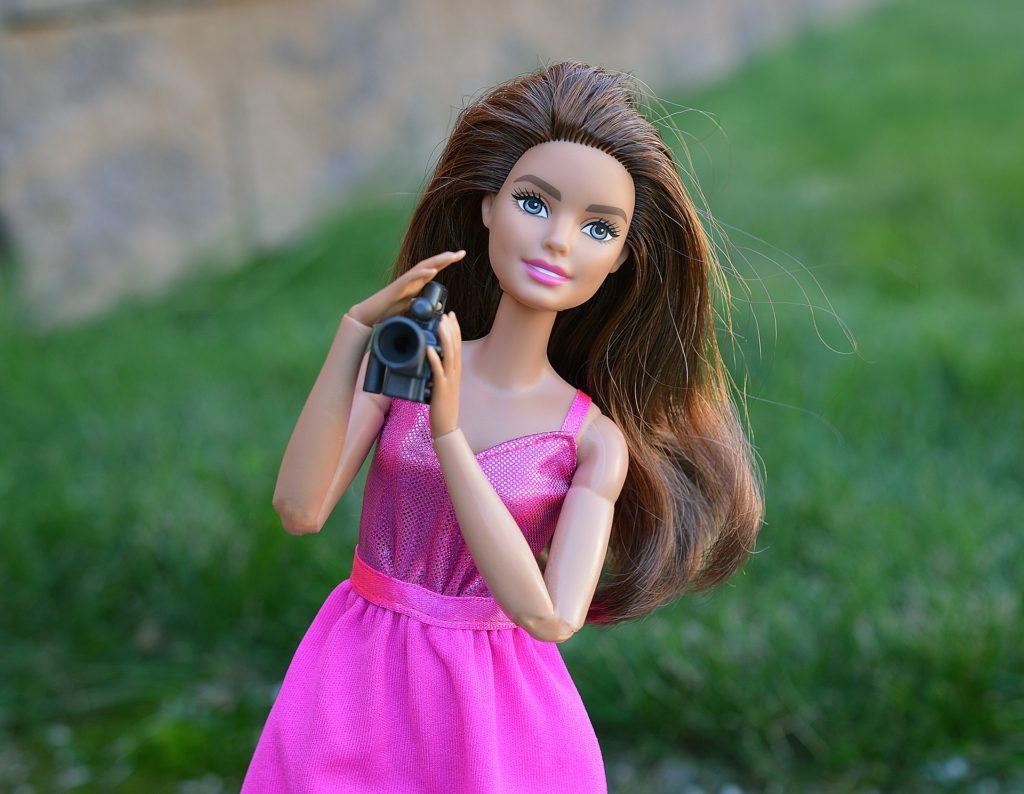
Barbie was a fashion icon toy first sold in March 1959. An American businesswoman named Ruth Handler created the now famous doll. She was inspired by a German doll called Bild Lilli. Barbie has been an important part of the toy fashion doll market for more than 50 years. Mattel has sold over a billion Barbie’s. It has become the company’s largest and most profitable line. Because of her strong, female empowerment, Barbie has become a staple toy for young girls. Peaches ‘N Cream Barbie was the epitome of the ’80s doll. The commercial starred a young Tiffani-Amber Thiessen from Saved by the Bell and Beverly Hills, 90210. The Love-You Barbie was dressed in a red-and-white-heart-dress, and she carried a heart-stamp and notes. It was a perfect addition for young girls just understanding crushes. Astronaut Barbie was special because she sent a message we all needed to hear: We girls can do anything. The world and the universe were our own. We could explore them with style. We could be intelligent and fun; we did not need to choose. Even though popularity has declined recently, the favorites from the ’80s are still considered the most memorable.
My Pet Monster
My Pet Monster was originally made by American Greetings in 1986. The character has horns, blue fur, and a fanged smile. The toy doll came wearing breakaway orange plastic handcuffs. The handcuffs can also be worn by children, who could easily break the chain. The doll was popular in the late 1980s and early 1990s as one of the few plush dolls marketed to boys at that time. Several versions of the doll have been made. They come with equally unique costumes and names like Gwonk, Wogster, and Rark. The characters came paired with unique toys like TV trays and coloring books. The character’s popularity led to a live-action movie in 1986. The film starred a boy who became the Pet Monster after he was exposed to a statue. When the monster wears his handcuffs, they turn him into a stuffed animal. Toyax released an updated version of the plush later in 2012. It also inspired a cartoon series a few years later. Monster’s still in mint condition are a favorite among toy collectors today.

